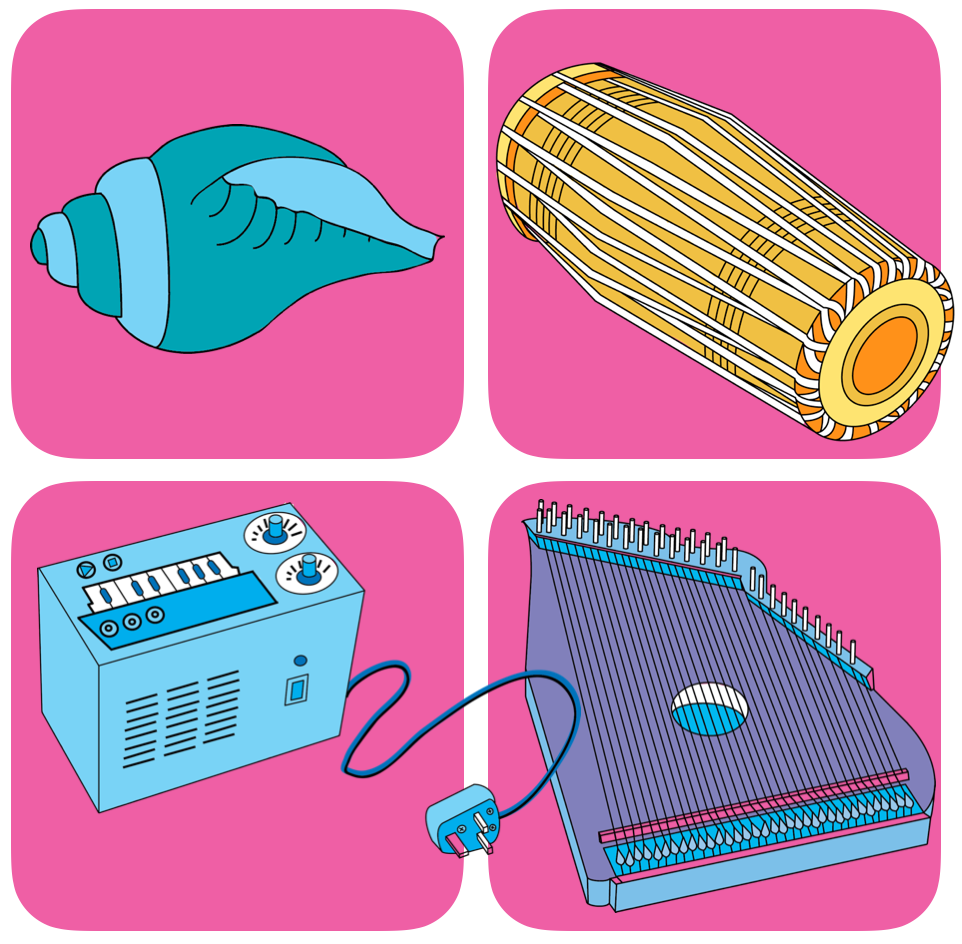As part of Milap’s latest venture with Dr Manuella Blackburn, the Instruments INDIA archive will be used as the basis of new sample packs that will showcase Indian instruments. Funded by the Arts and Humanities Research Council (AHRC), this project is primarily aimed at widening engagement with Indian musical instruments, supporting educational work and encouraging new lines of creativity.
On 10th March, the project team (Dr Manuella Blackburn, Alok Nayak, Hayley Suviste and Jonny Batchelor) gave a talk at the Digital Archive and Canon virtual workshop, entitled ‘Fragmenting the archive for creativity: developing digital sample packs of Indian musical instrument sounds’. In this talk we discussed the process of curating digital sample packs for commercial distribution from the larger Instruments INDIA sound archive. Established in 2013, the Instruments INDIA sound archive contains over five hours of sound recordings of 28 different Indian musical instruments. This digital resource was created to support music education initiatives and to enhance audience development for Indian classical music performances in the UK. The sounds were also integrated into a series of experimental electronic works exploring the position of culturally diverse materials in new contexts.
The Instruments INDIA archive has remained mostly inaccessible to the public, aside from sound bites available on the Instruments INDIA website. Turning this archive into a commercial sample pack means the sounds will be available to download by music producers who can use these sounds in their own musical works.
There are several ambitions behind this project. Firstly, we acknowledge a gap in the market for high quality sample packs on existing sample pack distribution sites. Those that are available often present problematic issues with crediting the artists, representation of diversity, and tend to fall into stereotyped notions of Indian musical instruments, rarely straying beyond sitar and tabla sounds. Secondly, we want to observe the practice of sample pack curation (sifting, selecting, formatting, and distributing) to better understand and support this fast-growing and popular industry of commercial sample pack creation and purchase. These improvements are mainly with regards to diverse sound materials and the representation of culturally diverse content, as well as the position of artists and their sound products. Sample pack distribution platforms all deal with this differently and we have started to see signs of good practice versus practices that are less desirable.
Throughout the project we will be working with the contributing musicians who appear in the archive to curate the samples from the existing sound recordings. This process of engaging in dialogue with musicians (Dr Rajeeb Chakraborty and Kousie Sen) has already started to reveal important considerations for the sound archive, which include formatting conventions (having to retime samples for use in DAWs) and the application of subtle effects (such as reverb, EQ, compression, and normalisation) to ‘touch up’ sound materials so they are ready for producers to use in their creations.
As we look back on the sound archive and reflect on decisions for its initial curation, we notice its achievements in capturing a number of rare, folk, and devotional instruments that are seldom heard outside of India. We recognise the vast diversity in playing styles via the recording of world-renowned musicians and those at the start of their performing careers. We acknowledge that the proposed sample packs are not able to stand for the entirety of all Indian musical instruments, but instead will provide a snapshot of creative talent packaged in a new form to further new creativity in areas as diverse as DIY bedroom producing, EDM, pop, hip-hop, and experimental musical work.
Throughout the year, we will be hosting a range of engagement events as part of this project. This includes an online panel event to share perspectives on sample pack representation, labelling, uptake and issues of diversity in this industry, with representatives from sample pack developers, Sound and Music (the UK’s national agency for new music) and Milap. There will also be an online Music Education Training session on cultural sound inclusion in the classroom, and a Call for Works in the summer with Sound and Music and MILAP, inviting creators to make use of the sample pack that we create in musical works. Then finally, based on our findings from throughout the project, we will create guidance and policy documents on diversity representation within sample pack development, which will be a code of practice for publication that will be available for sample pack users to engage with.
